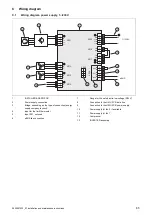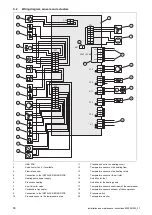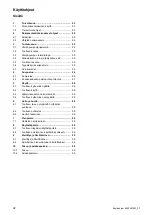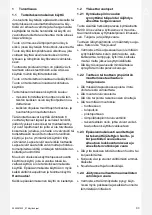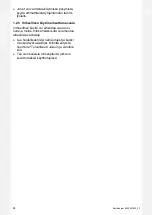
0020297933_07 Installation and maintenance instructions
79
11.2
Observing the work plan and intervals
▶
Comply with the specified intervals. Carry out all of the
work that is mentioned ( Appendix D).
11.3
Procuring spare parts
The original components of the unit were also certified as
part of the CE declaration of conformity. You can find inform-
ation about available Vaillant original spare parts by contact-
ing the contact address provided on the back page of these
instructions.
▶
If you require spare parts for maintenance or repair work,
use only Vaillant original spare parts.
11.4
Carrying out maintenance work
11.4.1 Checking the protective zone
▶
Check whether the defined protective zone is being
maintained in the area close around the product.
(
▶
Check that no subsequent construction-related changes
or installations that violate the protective zone have been
implemented.
11.4.2 Cleaning the product
▶
Only clean the product when all of the casing sections
and covers have been installed.
▶
Do not clean the product with a high-pressure cleaner or
a direct jet of water.
▶
Clean the product using a sponge and hot water with
cleaning agent.
▶
Do not use abrasive cleaners. Do not use solvents. Do
not use any cleaning agents that contain chlorine or am-
monia.
11.4.3 Removing the casing sections
1.
Before removing the casing sections, use a gas sniffer
to check whether refrigerant is escaping.
2.
Remove the casing sections to the extent required for
the subsequent maintenance work (
11.4.4 Closing the purging valve
Condition
: Only during the first service
1
▶
Close the purging valve
(1)
.
11.4.5 Checking the evaporator, fan and
condensate discharge
1.
Clean the gaps between the fins using a soft brush. In
doing so, avoid fins being bent.
2.
Remove any dirt and depositions.
3.
If required, straighten out any bent fins using a fin
comb.
4.
Turn the fan by hand.
5.
Check that the fan runs freely.
6.
Remove the dirt that has accumulated on the condens-
ate tray or in the condensate discharge pipe.
7.
Check that the water can drain freely. Poor approx. 1 l
water into the condensate tray.
8.
Ensure that the heating wire is inserted into the con-
densate discharge tundish.
11.4.6 Checking the refrigerant circuit
1
2
1.
Check whether the components and pipelines are free
from dirt and corrosion.
2.
Check that the covering caps
(1)
and
(2)
on the main-
tenance connections are positioned securely.
11.4.7 Checking the refrigerant circuit for tightness
1.
Check whether the components in the refrigerant circuit
and the refrigerant pipes are free from damage, corro-
sion and oil leaks.
2.
Check the refrigerant circuit for leak-tightness using a
gas sniffer. In doing so, check all of the components
and pipelines.
3.
Document the result of the leak-tightness test in the
service book.
11.4.8 Checking the electrical connections and
electrical wires
1.
On the connection box, check whether the seal is un-
damaged.
2.
In the connection box, check that the electrical wire are
seated firmly in the plugs or terminals.
3.
Check the earthing in the connection box.
4.
Check whether the power supply cable is damaged. If
it needs to be replaced, ensure that it is only replaced





















